
World-famous Russian programmer dies
14 January 2009: Mikhail Donskoy, an outstanding Russian IT specialist, one
of the developers of the Kaissa chess program, died on 13 January at the age
of 61. Kaissa was designed in the mid-60es by a group of Soviet mathematicians.
In 1967, it defeated the a program developed at the Stanford University, and
in 1974 became the first world champion in a chess programme competition.
Donskoy was also the chief system programmer for the INES data management system
and created the INES archival system. The INES system was in the 80es installed
at more than two thousand large production facilities across the USSR.
In 1988, Donskoy assembled a group of professionals to develop a new chess
game for PCs, based on the Kaissa algorithm. The group of experts was made into
the Paragraph company and later transformed into the independent firm DISCo,
headed by Mikhail Donskoy. [Original report in English,
Russian and
Tatar – but we could not find the last link].
Mikhail Donskoy, 1948–2009
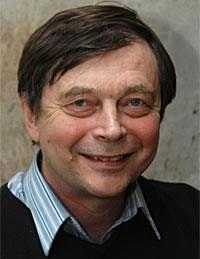 Mikhail
Vladimirovich Donskoy, (1948 - January 13, 2009) was a Russian computer scientist
and chess programmer. In 1971 he joined with Vladimir Arlazarov and Anatoly
Uskov to program the successor of the ITEP Chess Program on an ICL System 4/70
at the Institute of Control Sciences, called Kaissa, which became the first
World Computer Chess Champion in 1974 in Stockholm. The development of Kaissa
was accompanied by Georgy Adelson-Velsky, Alexander Bitman, Alexander Brudno,
Sasha Resnitsky, Boris Stilman and Mikhail Botvinnik.
Mikhail
Vladimirovich Donskoy, (1948 - January 13, 2009) was a Russian computer scientist
and chess programmer. In 1971 he joined with Vladimir Arlazarov and Anatoly
Uskov to program the successor of the ITEP Chess Program on an ICL System 4/70
at the Institute of Control Sciences, called Kaissa, which became the first
World Computer Chess Champion in 1974 in Stockholm. The development of Kaissa
was accompanied by Georgy Adelson-Velsky, Alexander Bitman, Alexander Brudno,
Sasha Resnitsky, Boris Stilman and Mikhail Botvinnik.
From 1982 Mikhail Donskoy was the chief system programmer for the INES DBMS,
the INES archive system original programmer. Since 1989 he was leader of the
programmers group later growing into DISCo (Donskoy's Interactive Software Company).
Mikhail Donskoy died of cancer at age 60. Misha Donskoy kept his illness a secret
even from his best friends, who were shocked to learn about his death. We contacted
two of them who sent us the following brief messages.
David Levy, London
Mikhail Donskoy was a kind and pleasant gentleman, and was an excellent ambassador
for his country when he came to Stockholm in 1974 with his chess program KAISSA,
there to win the first World Computer Chess Championship. Misha achieved much
in the early days of computer chess but was always modest about his achievements.
He was an excellent host to those from our community who had the good fortune
to meet with him when visiting Moscow, and he remained interested in computer
chess long after his own program ceased to participate. He and I were last in
touch as recently as last month, arranging for his son Andrew to take delivery
of a replica of the Shannon Trophy that the ICGA has made for all previous World
Computer Chess Championship winners.
Monty Newborn, McGill University, Canada
In the good old days when Capitalism and Communism clashed, there was one bright
light of cooperation between the West and the USSR that I was happy to be a
part of. In the world of computer chess, the Soviet scientists were eager to
cooperate with those of us in the West and us equally. Tony Marsland was the
first to become involved, but Ken Thompson and I also enjoyed the comradeship
and scientific involvement with Misha Donskoy and clan. Misha hosted us on a
number of visits and showed us the best of times. We spoke about politics for
hours with him. As a scientist and programmer he was first rate, with a strong
understanding of how computers should be programmed to play, and actually doing
the programming. He led the Soviet effort at a time when programming was far
more difficult than it is today, and computers were far less capable. Of course,
most notably, he will be remember as having developed the first world championship
chess program, KAISSA.
To which we add our own memories...
Frederic Friedel, Hamburg, Germany
I met Misha Donskoy twice in Moscow and at a number of computer chess events.
Once I was in Moscow with Ken Thompson, and we spent the afternoon with Mikhail
Botvinnik and his team of programmers who had developed the "intelligent"
program Pioneer. The same evening we visited Vladimir Alazarov, where Misha
was also present. The afternoon had been spent with diffuse explanations of
"force trajectories" and "attacking potential". In the evening
I listened to Vladimir and Misha explain to Ken how they were able to save a
few CPU cycles on each position in the (brute force) search with some clever
algorithmic tricks. The two teams were worlds apart. Late at night the ladies
left the room and Alazarov put four bottles of vodka on the dining table. When
I tried to pour myself a glass from the one he had opened he stopped me and
pointed to another. It was "my bottle," one each for of the four men
present. Once Donskoy was in Canada and we took him to what at the time was
the world's largest mall (I believe it was the West
Edmonton Mall). It had indoor roller coasters, swimming, skiing, ice hockey
– even an indoor beach. Misha looked around the gigantic, glittering mall
and had two words of comment: "Like GUM". [Only people from the Soviet
era will appreciate this comment. GUM
was a "department store" complex, directly adjacent to the Red Square
in Moscow. This
is what it looked like at the time. We had great times with Misha and thoroughly
enjoyed his wry humour. He will be missed.
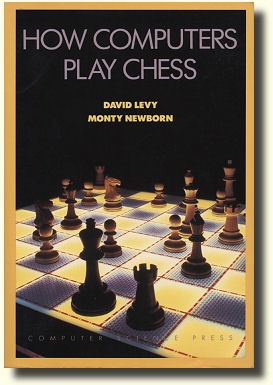 Excerpt
from the book How
Computers Play Chess by David N. L. Levy and Monroe Newborn, W H Freeman
& Co, August 1990. We reproduce it with kind permission of the autors. Note
that a number of present-day algorithms – like null move and killer heuristics
– were being used by the Kaissa team back in the 70s.
Excerpt
from the book How
Computers Play Chess by David N. L. Levy and Monroe Newborn, W H Freeman
& Co, August 1990. We reproduce it with kind permission of the autors. Note
that a number of present-day algorithms – like null move and killer heuristics
– were being used by the Kaissa team back in the 70s.
KAISSA
In 1971 a group of programmers at the Institute of Control Science began to
rewrite the ITEP program that had been used in the 1967 match with Stanford,
and by the following year it was ready, in its new form, to play a two game
match against the readers of the newspaper Komsomolskaya Pravda. On most Sundays
throughout 1972 the newspaper published KAISSA's moves in each of the two games
and the readers sent in their suggested replies. In every case the move suggested
by the majority of the readers was chosen and KAISSA's reply was published the
following week. KAISSA drew one game and lost the other. The previous year Spassky
had played two games against the readers of the same newspaper and scored one
win and one draw. Obviously the combined force of the readership of Komsomolskaya
Pravda produces rather strong chess and the program's result was quite creditable.
KAISSA's basic look-ahead was set at seven ply, with further analysis along
variations that involved captures and other forcing moves.
Thus KAISSA made its public debut. When the newspaper games ended the programming
team continued to work on the program. Altogether about ten people were involved,
including most of the group that created the ITEP program plus Mikhail Donskoy,
who had just graduated from Moscow State University and who assumed the leading
role in KAISSA's creation.
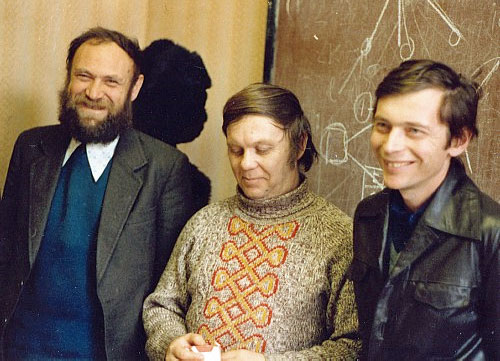
Soviet scientists (l-r): Vladimir Arlazarov, Alexander Ushkov and Mikhail
Donskoy at Moscow’s Institute for Control Science, who in 1971 created
the chess program Kaissa which included many original software features such
as “bit boards.”
KAISSA used a complex evaluation function involving many features. In fact
it was so complex that when I first asked Donskoy about it he replied "...
I don't even remember what is in it." The program used the familiar method
of searching all moves to a specified depth and then considering only captures,
checks, other forcing moves and moves that were replies to checks. An upper
bound of 30 plies was put on the depth of these forcing variations but this
depth was reached very seldom during the tree search.
KAISSA used a slight modification to the alpha-beta algorithm so that before
the search for a move began the values of alpha and beta were not set to minus
infinity and plus infinity (as was usually the case in those days) but to rather
narrower limits between which the value of the current position was expected
to lie. In this way the search was reduced still further. This technique is
known as windowing.

Monroe Newborn (far right, with daughter Amy) with the developers of the
Soviet chess computer Kaissa (from left): Sasha Resnitsky, Boris Stilman, Misha
Donskoy and former World Champion Mikhail Botvinnik
An improvement in the performance of the alpha-beta search was obtained by
using what the programmers called the "best move service." They point
out that in chess the number of possible moves (less than 10,000) is far smaller
than the number of possible positions and that a classification of moves is
therefore much easier than a classification of positions. The underlying principle
of the best move service is that a move which was the best in many similar positions
would most likely be plausible in the current position.
For each ply, ten moves were stored. These were the moves that were most frequently
the best ones in other positions at the same depth. When ordering the moves
from a particular position these "best moves" were put at the head
of the list and hence they were considered earlier. The application of the best
move service produced a ten-fold reduction in the time taken to search trees
whose basic depth was five plies. This use of best moves soon became known as
killer moves.
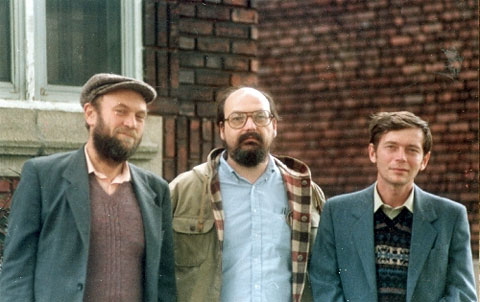
Vladimir Arlazarov, Ken Thompson and Mikhail Donskoy in 1992
Another innovation was the idea of introducing a dummy move at certain points
in the game tree. If it is White's turn to move and Black makes a "blank"
move then it is White's turn to move once again. If White can now gain a material
advantage then the previous White move must have carried this threat. Under
some circumstances a threat can be used to create a cut-off in the search process
and this technique can therefore lead to a further reduction in the search time.
Another use of the discovery of threats was that they can be included in the
list of moves that need to be examined.
KAISSA was able to reduce its search still further by being able to recognize
positions that were analogous to positions that had already been examined. If
a move is absurd in a particular position then it is likely to be absurd in
similar positions and it can therefore be excluded from the search until such
time as circumstances appear that change the variation arising after the absurd
move. A simple example of this strategy can be shown by considering the following
position.

Under normal circumstances a chess program would always consider the moves
Qd2-d4 and Qd2-g5 when making a move from this position, and KAISSA's use of
the blank move would normally result in these two moves being considered because
they are threats. But in the present position both moves are absurd because
they put the white queen en prise. Let us assume that White plays 1.a2-a3 and
that Black replies 1...a7-a5. Now most programs would once again consider 2.Qd2-d4
and 2.Qd2-g5, even though both moves are still absurd for the same reasons,
but KAISSA has a list of all the squares attacked by each of Black's pieces
and it would not consider Qd2-g5 until Black's h-pawn had advanced, nor would
it examine Qd2-d4 until the black knight had moved. This is how a human plays
chess and KAISSA's programmers pointed out that the standard of a human's play
increases with the accuracy with which he determines when a move rejected earlier
as absurd should be re-examined. (KAISSA defined absurd moves as those that
lead to the immediate loss of material.)
The only problem in implementing this "method of analogies" was in
deciding when the position had changed sufficiently to warrant re-examining
a move that was rejected earlier. KAISSA's programmers made some progress in
solving this problem but their research is beyond the scope of this book.
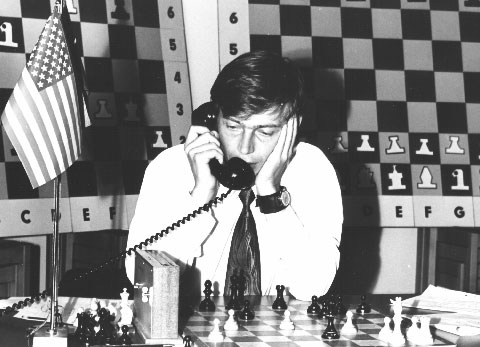
Misha Donskoy at the World Computer Chess Championship in Stockholm 1974
KAISS A's first appearance outside the Soviet Union came in August 1974 when
it participated in the 1st World Computer Championships in Stockholm. It won
two of its games very convincingly, it was temporarily in trouble in a third
and totally lost for much of the game in the vital last round. But in the end
KAISSA won all four games and the title of World Champion.
The second world computer chess championship in 1977 in Toronto, started with
an unusual occurrence that led to a position that has gone down in computer
chess history:
Duchess – Kaissa
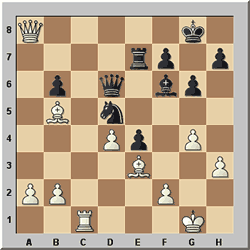
Black to move
In the diagram Kaissa, which played black, gave away a rook with the move 34...Re8?
and lost afterwards. A catastophic program bug, to give the rook for nothing?
That was what most of the spectators believed. But later the programmers entered
the obvious move 34...Kg7 into the program. Kaissa immediately explained why
it didn't like it: 34...Kg7 35. Qf8+!! Kxf8 36. Bh6+ Bg7 37. Rc8 and white checkmates
in two moves. This caused a sensation and was published in many chess magazines
of that time. None of the human spectators present saw this nice queen sacrifice.
As the result of this, Kaissa finished tournament 2nd-3rd (tied together with
the "Duchess" program).
Links
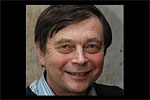


















 Mikhail
Vladimirovich Donskoy, (1948 - January 13, 2009) was a Russian computer scientist
and chess programmer. In 1971 he joined with Vladimir Arlazarov and Anatoly
Uskov to program the successor of the ITEP Chess Program on an ICL System 4/70
at the Institute of Control Sciences, called Kaissa, which became the first
World Computer Chess Champion in 1974 in Stockholm. The development of Kaissa
was accompanied by Georgy Adelson-Velsky, Alexander Bitman, Alexander Brudno,
Sasha Resnitsky, Boris Stilman and Mikhail Botvinnik.
Mikhail
Vladimirovich Donskoy, (1948 - January 13, 2009) was a Russian computer scientist
and chess programmer. In 1971 he joined with Vladimir Arlazarov and Anatoly
Uskov to program the successor of the ITEP Chess Program on an ICL System 4/70
at the Institute of Control Sciences, called Kaissa, which became the first
World Computer Chess Champion in 1974 in Stockholm. The development of Kaissa
was accompanied by Georgy Adelson-Velsky, Alexander Bitman, Alexander Brudno,
Sasha Resnitsky, Boris Stilman and Mikhail Botvinnik. Excerpt
from the book
Excerpt
from the book 










